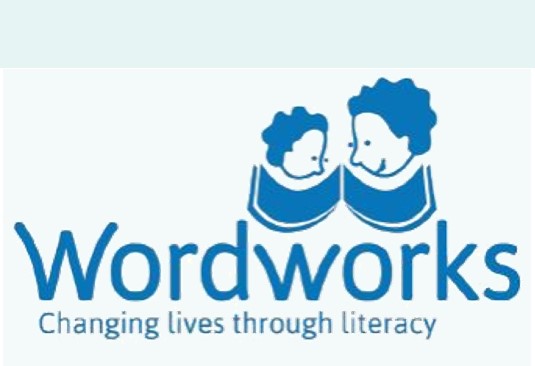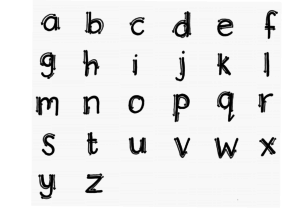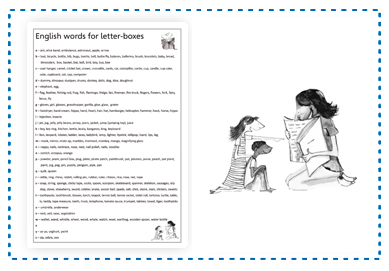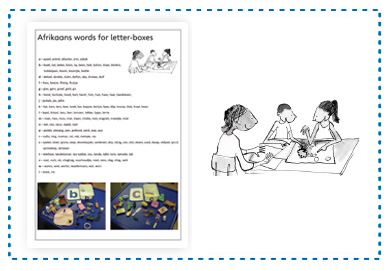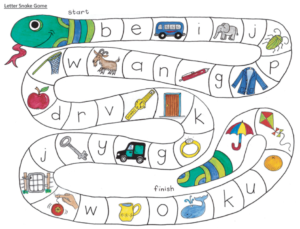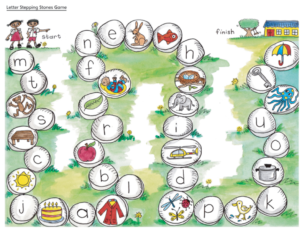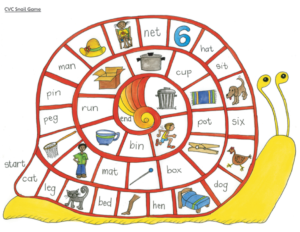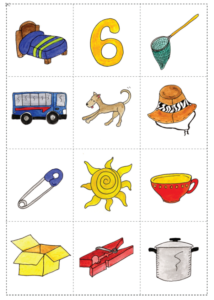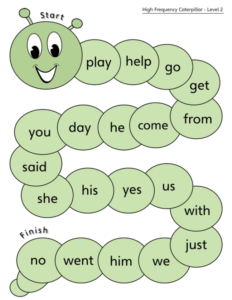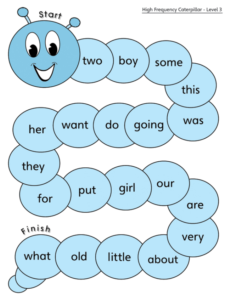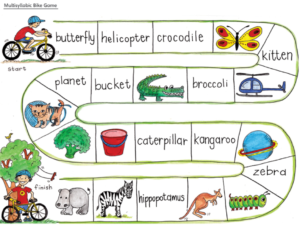Games
Alphabet and letter formation charts
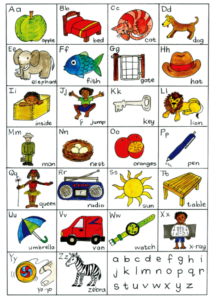 It is important that children are taught how to form letters correctly from the start. However, this does not mean that we focus on perfectly neat, well-formed letters when children first begin to write! On this page, you will find fun ideas for teaching children how to form letters and an alphabet chart which you can print and use as a reference.
It is important that children are taught how to form letters correctly from the start. However, this does not mean that we focus on perfectly neat, well-formed letters when children first begin to write! On this page, you will find fun ideas for teaching children how to form letters and an alphabet chart which you can print and use as a reference.
Download the alphabet chart in English
Download the alphabet chart in Afrikaans
Download the alphabet chart in isiXhosa
Download the alphabet chart in isiZulu
Download the letter formation chart
Letter formation activities
Use the letter formation sheet to show children the correct way to write letters.
NOTE: Start off making letters with BIG movements and if children are in Grade R avoid activities that involve writing letters between lines on paper.
Ideas for helping children learn how to form letters:
- Make letters out of play dough
- Write letters in big chalk and get children to walk on the lines of the letters
- Use sand trays for children to make letters with their fingers
- Fill polystyrene trays with jelly and get children to make letters with their fingers
- Use sticks to write letters in the sand
- Use water and a paintbrush to paint letters on concrete floors
- Cut out pictures from magazines; stick pictures that start with the same letter on a page
- Practise writing letters with a whiteboard marker on a wipe sheet (A4 paper inside a plastic sleeve)
The Alphabet Game
Letter boxes
The Word bird Game
Snake letter game
Good for: Improving letter-sound knowledge.
You will need:
a dice
a counter for each player (you can use buttons, coins, dried beans, bottle tops)
Instructions:
The child throws the dice and moves a counter around the board. If they land on a letter, they must say the sound and move their counter forward to a picture that starts with that letter. If they land on a picture, they must move their counter back to the matching letter. Whoever gets to the end of the board first is the winner.
Letter stepping stones game
Good for: Improving sound knowledge
You will need:
a dice
a counter for each player (you can use buttons, coins, dried beans, bottle tops)
Instructions:
The child throws the dice and moves a counter around the board. If they land on a letter, they must say the sound and move their counter forward to a picture that starts with that letter. If they land on a picture, they must move their counter back to the matching letter. Whoever gets to the end of the board first is the winner.
Download this game in Afrikaans.
Download this game in isiXhosa.
Download this game in isiZulu.
.
High frequency caterpillar game (level 1)
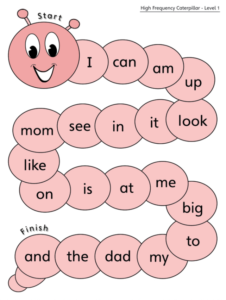 Good for: Improved reading of sight words (commonly used words that can be hard to sound out)
Good for: Improved reading of sight words (commonly used words that can be hard to sound out)
You will need:
a dice
a counter for each player (you can use buttons, coins, dried beans, bottle tops)
Instructions:
The child throws the dice and moves a counter around the board. The child must read the word that they land on (e.g. ‘see’) and make a sentence with the word (e.g. ‘I see a cat.’). Whoever gets to the end first is the winner.
CVC snake game
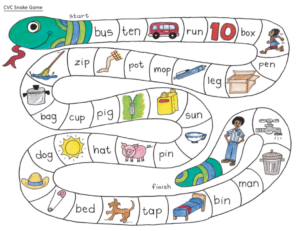 Good for: Practising reading simple three-letter words (CVC = consonant-vowel-consonant).
Good for: Practising reading simple three-letter words (CVC = consonant-vowel-consonant).
You will need:
a dice
a counter for each player (you can use buttons, coins, dried beans, bottle tops)
Instructions:
The child throws the dice and moves a counter around the board. If they land on a word, they must say the word and move their counter forward to a picture of that word. If they land on a picture, they must move their counter back to the matching word. Whoever gets to the end of the board first is the winner.
Download this game in Afrikaans.
Download this game in isiXhosa.
Download this game in isiZulu.
CVC snail game
Good for: Practising reading simple three letter words (CVC = consonant-vowel-consonant)
You will need:
a dice
a counter for each player (you can use buttons, coins, dried beans, bottle tops)
Instructions:
The child throws the dice and moves a counter around the board. If they land on a word, they must say the word and move their counter forward to a picture of that word. If they land on a picture, they must move their counter back to the matching word. Whoever gets to the end of the board first is the winner.
CVC Say-it-and-move-it
Good for: Helping children listen to each sound in a word and improving their writing skills.
You will need:
say-it-and-move-it board (laminated or placed inside a plastic sleeve)
picture cards
counters (beans or buttons)
whiteboard marker
Instructions:
Place a picture card (e.g. cat) on the board in the large block. Help the child to name the picture saying the word slowly so they can hear each sound. Take 3 counters and show the child how to move a counter into a small block as they say each sound of the word (c-a-t). Work from left to right. Remove the counters from the blocks and give the child a whiteboard marker so they can write each letter in a block to make up the word.
High frequency caterpillar game (level 2)
Good for: Improved reading of sight-words (commonly used words that can be hard to sound out).
You will need:
a dice
a counter for each player (you can use buttons, coins, dried beans, bottle tops)
Instructions:
The child throws the dice and moves a counter around the board. They must read the word they land on (e.g. ‘come’) and make a sentence with the word (e.g. ‘Come and play with me.’) Whoever gets to the end first is the winner.
Download the Caterpillar game in Afrikaans.
Games
Blend lily pad game
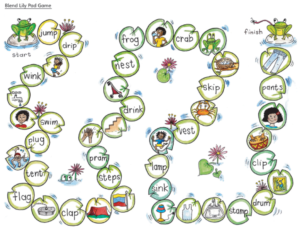
Good for: giving children practice reading longer words with blends. Blends are words with two consonants at the beginning or the end (eg. frog, nest, stand).
You will need:
a dice
a counter for each player (you can make counters from, buttons, coins, dried beans, bottle tops)
Instructions:
The child throws the dice and moves a counter around the board. If they land on a word, they must read the word and move their counter forward to a picture of that word. If they land on a picture, they must move their counter back to the matching word. Whoever gets to the end of the board first is the winner.
Blend train game
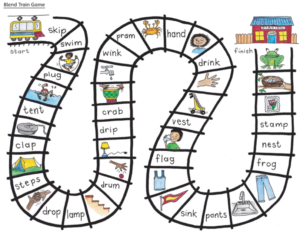 Good for: giving children practice reading longer words with blends. Blends are words with two consonants at the beginning or the end (eg. frog, nest, stand).
Good for: giving children practice reading longer words with blends. Blends are words with two consonants at the beginning or the end (eg. frog, nest, stand).
You will need:
a dice
a counter for each player (you can make counters from, buttons, coins, dried beans, bottle tops)
Instructions:
The child throws the dice and moves a counter around the board. If they land on a word, they must read the word and move their counter forward to a picture of that word. If they land on a picture, they must move their counter back to the matching word. Whoever gets to the end of the board first is the winner.
Download the Train game in Afrikaans.
Blend Say-it-and-move-it
Good for: Helpin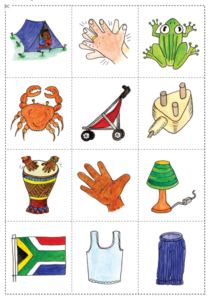 g children hear and write each sound in a word with a consonant blend. Blends are words with two consonants at the beginning or the end (eg. frog, nest, stand).
g children hear and write each sound in a word with a consonant blend. Blends are words with two consonants at the beginning or the end (eg. frog, nest, stand).
You will need:
say-it-and-move-it board (laminated or placed inside a plastic sleeve)
picture cards
counters (beans or buttons)
whiteboard marker
Instructions:
Place a picture card (eg cat) on the board in the large block. Help the child to name the picture saying the word slowly so they can hear each sound. Take 3 counters and show the child how to move a counter into a small block as they say each sound of the word (c-a-t). Work from left to right. Remove the counters from the blocks and give the child a whiteboard marker so they can write each letter in a block to make up the word.
High frequency caterpillar game (level 3)
Good for: Improving reading sight-words (commonly used words can be hard to sound out).
You will need:
a dice
a counter for each player (you can make counters from, buttons, coins, dried beans, bottle tops)
Instructions:
The child throws the dice and moves a counter around the board. Help them read the word they land on (e.g. ‘come’) and make a sentence with the word (e.g. ‘Come and play with me.’). Whoever gets to the end first is the winner.
Multisyllabic bike game
Good for: helping children sound out longer words and break them up into parts.
You will need:
a dice
a counter for each player (you can use buttons, coins, dried beans, bottle tops)
Instructions:
The child throws the dice and moves a counter around the board. They must read the word they land on and move their counter forward to a picture that matches the word. If they land on a picture, they must move their counter back to the matching word. The child who gets to the end of the board first is the winner.
Multisyllabic river game
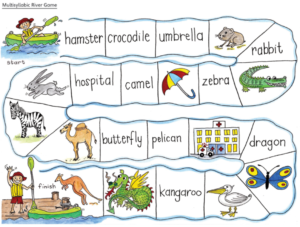 Good for: Helping children sound out longer words and break them up into parts.
Good for: Helping children sound out longer words and break them up into parts.
You will need:
a dice
a counter for each player (you can use buttons, coins, dried beans, bottle tops)
Instructions:
The child throws the dice and moves a counter around the board. They must read the word they land on and move their counter forward to a picture that matches the word. If they land on a picture, they must move their counter back to the matching word. The child who gets to the end of the board first is the winner. Watch the instruction video.
